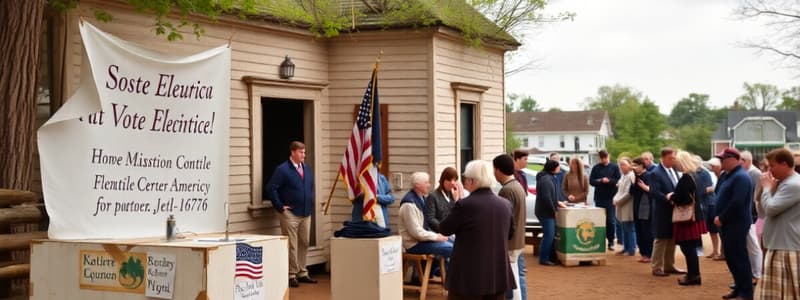Podcast
Questions and Answers
In order to govern themselves, the state legislators need to write their state constitution.
In order to govern themselves, the state legislators need to write their state constitution.
True (A)
The election for the state legislator takes place in the fall of 1776.
The election for the state legislator takes place in the fall of 1776.
False (B)
Candidates must include their mother's name on their campaign posters.
Candidates must include their mother's name on their campaign posters.
False (B)
Candidates are allowed to choose any state from the 13 colonies to represent.
Candidates are allowed to choose any state from the 13 colonies to represent.
A picture of the candidate is not necessary for the campaign poster.
A picture of the candidate is not necessary for the campaign poster.
Researching the issues of the colonies is a part of preparing for the campaign.
Researching the issues of the colonies is a part of preparing for the campaign.
The candidates have only one day to complete their poster assignments.
The candidates have only one day to complete their poster assignments.
Candidates should focus on trade and fishing issues if most of their population lives on the coastline.
Candidates should focus on trade and fishing issues if most of their population lives on the coastline.
Only wealthy landowners were eligible to vote in federal elections during the early 19th century.
Only wealthy landowners were eligible to vote in federal elections during the early 19th century.
Women gained the right to vote in federal elections in the United States before black males.
Women gained the right to vote in federal elections in the United States before black males.
Some states allowed women to own land and vote at different points in history.
Some states allowed women to own land and vote at different points in history.
In the election of 1800, about 22,000 individuals were eligible to vote from a population of 2.5 million.
In the election of 1800, about 22,000 individuals were eligible to vote from a population of 2.5 million.
The rights to vote were uniformly applied across all states in the 18th and 19th centuries.
The rights to vote were uniformly applied across all states in the 18th and 19th centuries.
Black women were able to own land in southern states after the Civil War.
Black women were able to own land in southern states after the Civil War.
The right to vote in local elections was independent of land ownership in some states.
The right to vote in local elections was independent of land ownership in some states.
Changes to voting laws were solely based on public opinion and not on written documents.
Changes to voting laws were solely based on public opinion and not on written documents.
Flashcards
State Constitution
State Constitution
The fundamental set of rules and principles that governs how the state is organized and run.
State Legislature
State Legislature
A system of government where a group of elected officials (legislators) make laws and decisions for the state.
Research
Research
The process of examining, analyzing, and investigating information to learn more about a particular topic.
Choosing a State
Choosing a State
Signup and view all the flashcards
Contextual Information
Contextual Information
Signup and view all the flashcards
Creating Your Likeness
Creating Your Likeness
Signup and view all the flashcards
Platform Statement
Platform Statement
Signup and view all the flashcards
Identifying State Issues
Identifying State Issues
Signup and view all the flashcards
Land Ownership and Voting Rights
Land Ownership and Voting Rights
Signup and view all the flashcards
Limited Voting Population
Limited Voting Population
Signup and view all the flashcards
Unequal Suffrage
Unequal Suffrage
Signup and view all the flashcards
1800 Election: A Tiny Electorate
1800 Election: A Tiny Electorate
Signup and view all the flashcards
Laws and Constitutions Shape Voting Rights
Laws and Constitutions Shape Voting Rights
Signup and view all the flashcards
Land & Voting Rights for Black Men
Land & Voting Rights for Black Men
Signup and view all the flashcards
Inconsistent Voting Rights for Women
Inconsistent Voting Rights for Women
Signup and view all the flashcards
Power Dynamics and Voting Restrictions
Power Dynamics and Voting Restrictions
Signup and view all the flashcards
Study Notes
State Legislator Election in 1776
- Goal: Govern the state and write the state constitution
- Target Audience: Voters in a specific colony of your choice (out of the 13).
- Poster Requirements: Name, picture, and the state represented. A statement that details your goals and reason for running.
- Voter Eligibility: Only wealthy landowners could vote.
- Importance of Research: Research 1776 colony issues for the campaign poster.
- Types of Issues to Include:Trade, fishing regulations and other relevant colony issues.
- Timeline: A full week is allocated for the assignment.
Voter Requirements in 1776
- Limited Voter Base: Only landowners could vote. Rich landowners are the target population
- Land Ownership and Voting Rights: Land ownership was the primary requirement for voting, this is true for other elections up to the 19th century.
- Historical Context: The limited voter base was a consequence of the desire of those in power to maintain control.
- Legal Framework: Voting rights hinged upon state constitutions and laws, not universal criteria. This fact is a fundamental legal concept.
- Varying State laws: State constitutions governed voting requirements, which led to different eligibility criteria in different states, for example, some states allowed women to own land, and thus to vote.
- Evolving Voter Eligibility: Voting rights evolved for various groups over the 150 years after 1776, such as black males and women. These changes are tied to state constitutions.
- Limited Population in 1776: The total number of citizens eligible to vote in 1800 was roughly 22,000.
Studying That Suits You
Use AI to generate personalized quizzes and flashcards to suit your learning preferences.




